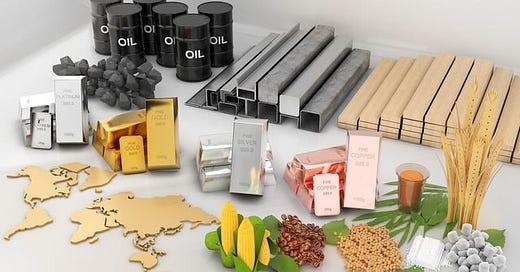Why the Blokland Smart Multi-Asset Fund does not invest in commodities.
Simply because they are not intrinsically scarce.
I often get the question: 'Why does the Blokland Smart Multi-Asset Fund not invest in commodities?'
My short answer: 'Commodities, as a group, are not intrinsically scarce.'
The fund's philosophy is to invest in the exact opposite of assets with massive supply and are over-represented in the investment universe. Hence, it stays away from debt and bonds (which will see lower returns, higher volatility, and fewer diversification benefits) and invests in assets that are hard to create, issue, or mine, like quality stocks, gold, and Bitcoin. Commodities do not fit that definition.
A mixed bag
Take the Bloomberg Commodity Index. It looks like this:
Energy ~ 30%
Grains ~ 23%
Precious Metals ~ 19%
Industrial Metals ~ 15%
Soft Commodities ~ 7%
Livestock ~ 5%
In nearly all cases, when investors allocate to Commodities, they do so based on the Bloomberg Commodity Index or another broad commodity index, including all six 'groups' of commodities. You do not have to be a rocket scientist to understand that Grains, Soft Commodities, and Livestock are not scarce. Together, these three groups make up more than one-third of the index. This leaves aside the fact that the commodity characteristics within these groups are also very different. Coffee, cotton, and sugar are very different, yet they all qualify as 'Soft Commodities.'
But that's not all. Even though supply and demand imbalances can persist over long periods, Industrial Metals like copper are also not intrinsically scarce. The mandated "Green Revolution,' unrealistic as its targets may be at this point, will likely result in a long-lasting supply-demand gap, increasing the odds of higher prices. But at some price, supply will start to catch up. In addition, while it has become increasingly difficult to get (more) oil out of the ground, and the discovery of new major oil fields has been on the decline, policymakers have decided that the demand for oil must at one point reach zero. Hence, oil is not intrinsically scarce.
Gold as a scarce asset class
Truly scarce commodities are found in Precious Metals, representing less than one-fifth of the Bloomberg Commodity Index. If one includes the market cap of an asset in the investment decision, an aspect commonly overlooked by many investors, gold, which represents a weight of over 15% of the index, is the only feasible scarce commodity. However, as gold is not consumed, traditional supply and demand dynamics do not apply. On top of that, gold has many other features that go beyond traditional commodities. It used to be money and can still be used as money in many places worldwide. And it is acknowledged by most investors and people as a store of value. This makes me conclude that gold must be seen as a separate asset class and not as a commodity in the traditional sense.
To be clear, there can be (temporary) good reasons to buy commodities, not in the least because they have proven inflation-hedging characteristics. However, they do not qualify as intrinsically scarce assets. In a world flooded with debt, the Blokland Smart Multi-Asset Fund will only invest in truly scarce assets.
Interested in the Blokland Smart Multi-Asset Fund?
Contact me at jeroen@bloklandfund.com or visit the website.
Want to have a call first? Use this link to book a one-on-one conversation and choose a suitable time slot. You can opt for a Zoom meeting or a phone call. Please note that the minimum entry amount is EUR 250k, which can be lowered to a minimum of EUR 100k in consultation.
Let’s invest together!
Kind regards,
Jeroen






